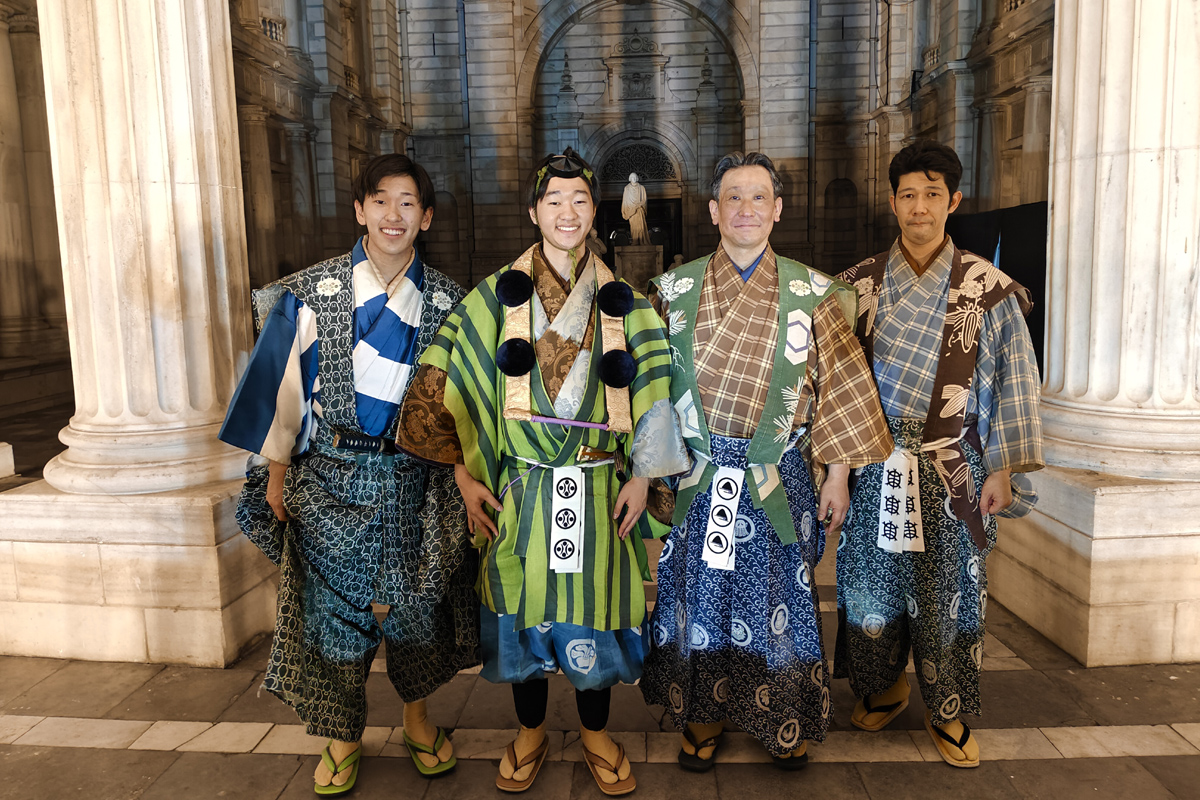Konnichiwa, comedy connoisseurs! Get ready to dive headfirst into the zany realm of Kyogen, where ancient Japanese tales meet modern-day humour, laughter flows like sake and punchlines pack a harder punch than a sumo wrestler. From mischievous antics that’d make even a ninja blush to quips as quick as a samurai’s sword, Kyogen is the comedic equivalent of a bonsai tree: small in stature but packed with laughter-inducing surprises.
What is Kyogen?
Advertisement
Kyogen, a quintessential form of Japanese comedy, serves as a delightful window into the daily lives of ordinary folk during the middle ages. With a keen eye for the absurd, Kyogen paints a vivid portrait of human interactions steeped in humour. Whether it’s the comical exchanges between master and servant, priest and layman, or husband and wife, every encounter brims with bumbling mishaps and hilarious misunderstandings. Yet, fear not, for in the world of Kyogen, these blunders are not met with catastrophe but with witty retorts, jovial songs and spirited dances.
Advertisement
From misinterpreted instructions leading to uproarious puns to deliberate deception and marital squabbles, Kyogen’s humour knows no bounds. Even in the midst of ineptitude, there’s an air of celebration, often expressed through lively music and dance. However, not all Kyogen tales aim to mock human foibles. Some delve into the tender intimacy of a moonlit night or the profound emotions of marital love, seamlessly blending humour with poignant moments of pathos. Truly, Kyogen is a multifaceted gem that offers a rich tapestry of laughter, warmth and insight into the human experience.
During the Warring States period (1467-1568), Kyogen emerged as a distinct art form, often sharing the stage with Noh performances. Rooted in sangaku, just like Noh, Kyogen has maintained close ties with its theatrical counterpart since its inception. However, the primary distinction lies in Kyogen’s emphasis on eliciting laughter, an emotional response rarely found in Noh performances. This comedic element harks back to sangaku’s essence, suggesting that Kyogen is the torchbearer of its original form, inheriting and preserving its comedic legacy. This traditional comedic art form, without elaborate stage settings, relies solely on hand props and physical actions to convey various expressions and transitions, evoking changes in scenery and time.
The Shigeyama Sengoro family
The Shigeyama Sengoro family stands as a venerable Kyogen troupe, boasting a rich history of patronage from both the Kyoto Imperial Palace and the feudal lord of Hikone. Over the years, three of its former leaders have been honoured with the prestigious title of ‘Living National Treasure’ by the Japanese government, underscoring their significant contributions to preserving and promoting this cherished cultural heritage.
Kyogen, which evolved alongside Noh theatre, is currently represented by two major schools: the Okura School and the Izumi School. The esteemed Shigeyama Sengoro Family is affiliated with the Okura School, carrying on its legacy through generations. The name ‘Shigeyama Sengoro’ traces its roots back to the Edo period (1603-1868) and has been transmitted through the family line. The current Sengoro holds the 14th generation of this esteemed title. During the tenure of the 10th generation Sengoro, in a bid to infuse Kyogen with a more accessible appeal to the general public, the family pioneered performances outside the confines of the traditional Noh theatre. This move aimed to strip away formalities and bring Kyogen to various casual settings, enhancing its enjoyment for audiences across different venues.
Recently, the Shigeyama Sengoro Family graced the Western Quadrangle of the Victoria Memorial and the JW Marriott in Kolkata with their performances, marking the birth anniversary of the Emperor of Japan. Speaking to The Statesman, Shigeyama Sengoro XIV expressed his excitement, stating, “This is our inaugural performance in India. I’ve been involved with Kyogen since the age of four. Bringing this more-than-650-years-old archetypal Japanese humour to India, we earnestly hope to bring joy to the audience.” Alongside Shigeyama Tatsumasa, Shigeyama Toramasa and Iguchi Tatsuya, Shigeyama Sengoro XIV presented three plays, each described in detail below.
Addressing the spectators, Mr Nakagawa Koichi, the Consul General of Japan in Kolkata, conveyed his optimism regarding the audience’s heightened interest in Japanese culture. He expressed his aspiration for the event to serve as a catalyst in fostering greater people-to-people exchanges between Japan and Kolkata.
Kaki Yamabushi (The Persimmon Thief)
In this uproarious tale of deliberate mistaken identity and unexpected alliances, we find ourselves following the misadventures of a Yamabushi making his way home to Mount Haguro in the Land of Dewa. Having endured the rigours of ascetic training on Mounts Omine and Katsuragi, our warrior priest finds himself in the throes of thirst, his parched throat yearning for relief. Spotting a tempting persimmon tree along the roadside, our famished protagonist seizes the opportunity to quench his thirst, indulging in its succulent fruits with gusto. Little does he know, he has unwittingly trespassed upon the domain of a mischievous farm owner, who happens upon the scene and decides to have a bit of fun at the Yamabushi’s expense. With quick wit and a sharp tongue, the farm owner teases the Yamabushi, likening him first to a crow, then a monkey and finally a kite. Each time, our bemused warrior priest plays along, cawing, scratching and even attempting to fly upon command. But alas, his attempts end in a painful tumble to the ground, much to the delight of the farmer.
Yet, just as the farmer begins to walk away, laughter echoing in his wake, the Yamabushi’s cunning comes into play. Channelling the power of sutras, he calls upon the farmer, drawing him back with a magnetic force that cannot be ignored. The farmer agrees to carry the Yamabushi home on his back, offering to tend to his injuries along the way. However, true to his mischievous nature, the farmer’s altruism proves short-lived as he unceremoniously dumps the Yamabushi and disappears into the distance, laughter trailing behind him like a mischievous breeze.
In this witty critique of human nature and the absurdity of circumstance, we’re treated to a delightful romp through the facets of mischief, deception and the timeless art of a well-timed ribbing.
Bo Shibari (Tied to a Stick)
In this uproarious comedy of mischief and retribution, we find a master seething with discontent over his sake-loving servants’ thievery. Determined to teach them a lesson, he enlists the unwitting aid of Taro Kaja in a clever scheme to trap their accomplice, Jiro Kaja. With cunning and wit, Taro Kaja suggests a punishment disguised as a demonstration of stick fighting, only to find himself ensnared in the master’s trap of his own making. Bound and determined to quench their thirst, the mischievous duo concocts a plan to liberate the sake cellar, despite their precarious predicament.
As the sake flows freely and inhibitions fade, the servants indulge in a merry dance of inebriation, their laughter ringing out in defiance of their master’s rules. Yet, their revelry comes to an abrupt halt when the master returns, his stern visage reflected back at them from the depths of a sake cup.
In a hilarious twist, the servants mistake their master for a vengeful spirit, only to be met with a very real scolding and a swift chase offstage. It’s a riotous gambol through the folly of deceit and the intoxicating allure of forbidden fruit, leaving both audience and characters alike in stitches of laughter.
Oni-Gawara (The Demon-Faced Tile)
Our story begins with a lord named Daimyo, whose fortunes soar as he clinches victory in court, secures a vast swath of new land, and earns leave to return to his roots. But before embarking on his journey homeward, he pays a visit to the revered Soul Healing Buddha at Inaba Temple, accompanied by his loyal servant Taro Kaja. His plan? To express gratitude for his windfall and lay the groundwork for a personal shrine in his hometown. This initial premise sets the stage for what promises to be a noble endeavour tinged with a hint of whimsy. At its heart, the narrative serves up a delectable blend of humour and insight, inviting us to ponder the absurdity of human emotion while revelling in the quirks of fate.
With meticulous attention, the lord scrutinises every inch of the temple, marvelling at its intricate craftsmanship and the diverse array of timbers that compose its sacred structure. He extols the virtuosity of the Hida artisans responsible for its creation, acknowledging them as true masters of their craft. Yet, amidst this admiration, his gaze fixates on a peculiar sight: a demon-faced tile perched above the eaves. Suddenly, tears flow freely from Daimyo’s eyes, prompting Taro Kaja’s concerned inquiry. Through sobs, the lord reveals that the demon-tile bears an uncanny resemblance to his dear wife. He recounts, in vivid detail, the haunting similarities between the grotesque visage and his beloved’s countenance, each feature a poignant reminder of her absence.
With gentle reassurance, Taro Kaja offers solace, reminding his master of the imminent reunion with his wife upon their return home. Why weep when joy awaits? Laughter, not tears, should accompany their journey. And so, with spirits uplifted, the lord and his servant share a hearty laugh before setting forth on the road homeward.
The author is a journalist on the staff of The Statesman.
Advertisement











